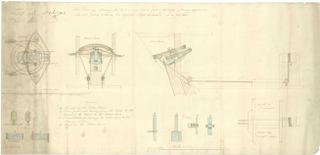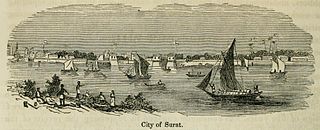Related Research Articles

Colonel William Henry Sykes, FRS was an English naturalist who served with the British military in India and was specifically known for his work with the Indian Army as a politician, Indologist and ornithologist. One of the pioneers of the Victorian statistical movement, a founder of the Royal Statistical Society, he conducted surveys and examined the efficiency of army operation. Returning from service in India, he became a director of the East India Company and a member of parliament representing Aberdeen.
Calcutta time was one of the two time zones established in British India in 1884. It was established during the International Meridian Conference held at Washington, D.C. in the United States. It was decided that India had two time zones: Calcutta would use the 90th meridian east and Bombay the 75th meridian east. It was determined as 5 hours, 53 minutes and 20 seconds ahead of Greenwich Mean Time (UTC+5:53:20).
The Bani Bu Ali expedition (1820–21) was a punitive campaign launched by the Sultan of Muscat and the East India Company against an Omani tribe known as the Bani Bu Ali in southeastern Arabia. It consisted of two expeditions. The first was the only land campaign Said bin Sultan conducted in Arabia during his long reign. It included a small allied British force and was defeated. The second, led by a more substantial British component, resulted in a decisive victory over the Bani Bu Ali. Company units engaged in the expedition received the "Beni Boo Alli" battle honour.
Sir Robert Townsend Farquhar, 1st Baronet was an influential British merchant of the early nineteenth century who served as a colonial governor and Member of Parliament. During his lengthy service for both the East India Company and the British government, Farquhar gained a reputation as an efficient and ambitious administrator and he notably served as Lieutenant-Governor of Prince of Wales Island from January 1804 to 1805 and as governor of Île de Bourbon, now known as Réunion from 1810 to 1811.
Henry Dominic Phillips was a British civil servant of the Indian civil service who served as an official member of the Madras Legislative Council from 1863 to 1868. He took his seat in December 1864.
Coromandel was a sailing ship built at Quebec in 1834. She was owned by Ridgeway and her home port was Glasgow. She was the first ship to bring settlers to South Australia after it was proclaimed a colony in 1836 and one of the early ships bringing New Zealand Company settlers to Wellington, New Zealand in 1840.
Robert Andrews was the Resident and Superintendent of British Ceylon. He was appointed on 12 February 1796 and was Resident until 12 October 1798. He was succeeded by Frederick North as Governor of British Ceylon.
John Staples Harriott (1780–1839) was a British army officer stationed in India, in the service of the East India Company. He came to acquire the Jami' al-tawarikh in its original manuscript. In his studies of the Roma people, he made an identification with a legend of Bahram Gur and the Luri to support a Romani presence in Sasanid Persia, now considered to be an unjustified and uncritical deduction that has persisted.
Henry Augustus Marshall was a British colonial administrator in British Ceylon.
Hastings was a brig that the Bombay Dockyard launched in 1785 or 1787 for the Bengal Pilot Service. In 1818, the EIC sold her to local buyers. Alternatively, in May 1818 she was converted to a buoy vessel; in 1819 she appeared as a buoy vessel on a list of pilot vessels at Calcutta with J.F. Twisden, master. She was sold on 11 October 1820. A fire destroyed her on the night of 17 April 1823, while she was at Pulau Pasang, off Padang.
The Advocate-General of Bombay was charged with advising the Government of the British administered Bombay Presidency on legal matters. The Presidency existed from 1668 to 1947. Prior to 1858, when it was administered by the East India Company, the Advocate-General was the senior law officer of that company and also the Attorney-General of the Sovereign of Great Britain. He was an ex-officio member of the Legislative Council.

George Parbury (1807–1881) was a British publisher with a special interest in India, a freemason in India and London, Master of Merchant Taylors livery company, Justice of the Peace for two counties and Deputy Lieutenant of the Tower Hamlets.
Captain Joseph Nourse CB was a Royal Navy officer who became commander-in-chief of the Cape of Good Hope Station.
William H. Allen and Company was a bookselling and publishing business in London, England, at first known for issuing works related to the British colonies. It operated from headquarters in Leadenhall Street, later moving to Waterloo Place. Early owners and staff included James P. Allen, William Ferneley Allen, and William Houghton Allen.

HMS Cruizer was a Snake-class ship-sloop launched in 1828 for the British Royal Navy. The ship was built as a revival of the retired Snake-class ship-sloops. The Navy converted her to a brig in 1831, back to a ship in 1840, and sold her at Bombay in 1849.
The Asiatic Journal and Monthly Register for British India and its Dependencies was a regular publication which aimed to be “a faithful register of Indian Occurrences”.
Events from the year 1842 in China.

In April 1837, a fire broke out in the Indian city of Surat, then under British East India Company rule. It resulted in more than 500 deaths and the destruction of 9,737 houses in a 93⁄4 mile radius. It was the most destructive fire in the history of the city.

Louis Sansoni served as the second Postmaster General of Ceylon, between 1816 and 1825.
References
- Great Britain India Office (1819). The India List and India Office List. Vol. I. Harrison. p. 127 . Retrieved 8 January 2009.